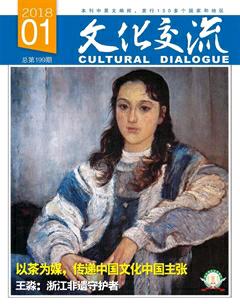我欲腾云上天都
孙国维
中共十九大勝利闭幕后,北京文艺舞台好戏连台。继北京人艺在首都剧场由何冰、宋丹丹、濮存昕、杨立新和徐帆五大主演联袂登场的京味话剧《窝头会馆》受到热捧之后,德国交响乐团在中山公园音乐堂奏响了贝多芬作品以纪念他逝世190周年。电视连续剧《急诊室医生》正在热播,央视网音乐频道则在现场直播《长相知——中国古典诗词音乐会》。更吸引眼球的还是在中国美术馆举办的《“沧海一粟——刘海粟艺术展》。
画尽神州尤爱黄山奇景
这次展览共展出101幅大师的书画作品。涉及多种题材和风格,是近年来刘海粟作品难得一见的全面回顾。展览共分三个篇章:(一)“我欲腾云上天都”。展出28幅黄山作品。其中,11幅是油画,17幅是泼墨泼彩;(二)“今日荷花别样红”。包括34幅以花鸟山水为主的中国画和2幅书法;(三)“神州尽在彩雾中”包括中国各地风景的37幅油画。
刘海粟对黄山情有独钟。一生中最重要的作品也以黄山为主要题材。他一生曾经十上黄山,成为旅游和美术界的美谈。他爱黄山成癖。他描述黄山为“天下绝秀”:千峰万嶂,干云直上,不傲不附,如矢如林,幽深险怪,诡奇百变。他的代表作就是《黄山云海奇观》和《披着狐皮的姑娘》,后者是他的第三任妻子。可见他爱黄山如同娇妻。1982年,他第九次上黄山,作诗歌颂黄山道:“黄山七十有二峰,峰峰削出青芙蓉,天风海涛曲未终,涧泉鸣树风鸣松。”刘海粟与黄山之缘跨度长达70年之久。从写意到创造,从“昔我师黄山”到“今做黄山友”。画家与表现对象由神遇而迹化,成为不分你我的整体。
传奇经历铸就艺坛大师
展览特意介绍了海翁的生平及其传奇经历。他姓刘名海粟,字季芳,号海翁。别署静远老人,存天阁主。生于1896年3月16日,祖籍江苏常州,卒于1994年8月7日,属于跨世纪老人。他的艺术遗产十分丰富,人生阅历尤其可贵。他是我国上个世纪涌现的“百年巨匠”中极负盛名的画家和美术教育家。1912年创办上海图画美术院(后改为上海美术专科学校),1949年任南京艺术学院院长。早年学油画,风格仓古浑雄,兼学国画,线条有刚劲铁骨之力。后又潜心于泼墨画法,走笔龙蛇,彩墨纵横,在美术界树一代新风。曾担纲上海艺术家协会主席和中国美术家协会顾问。
1914年,年仅19岁的刘海粟在他创办上海美专破天荒地开设了人体写生课,起初雇用男模特,后来启用女模特,舆论大哗。1917年,举办上海美专成就展览会,公开陈列人体模特作品,某女校校长竟破口大骂刘海粟是“艺术叛徒”、“教育界的蟊贼”。一石激起千层浪,自此,刘海粟不得安宁。许多美术界同行有的给予同情和支持,有的与其分道扬镳。军阀孙传芳自己三妻四妾,生活糜烂,对于海翁的艺术革新和创见却斥之为大逆不道。他一边声讨,一边下令通缉,扬言要焚烧美专,气势汹汹,大有泰山压顶之势。海翁不得不暂避风头,出国游历。
1918年刘海粟到北京大学讲学,并举办他第一次个人画展,获得广泛好评。其中,蔡元培和郭沫若的赞许和鼓励使他信心倍增。第二年他东渡日本,参加帝国美术院开幕大典,并和日本画家藤岛武二等交游论艺,切磋画技。《朝日新闻》为他在东京举办画展。海翁的绘画艺术受到日本同行的赞许,他被推崇为“东方艺坛的雄狮”。回国后,他充实了画院的设备和课程。并著有《米勒传》和《塞尚传》,向国内美术界介绍西方画坛的艺术经验和成就。1929年海翁赴欧洲访问,考察游历法国、意大利和瑞士等国。3年内创作了近百幅油画作品。曾两次入选法国秋季沙龙,获得法国美术界好评。他曾与毕加索、马蒂斯等画坛大伽交游论艺。巴黎大学教授路易·拉罗拉撰文称赞他为“中国文艺复兴大师”。1930年欣逢比利时独立纪念,海翁应聘为美术馆平陈委员。他的作品《九溪十八涧》获得荣誉奖。当年,《海粟油画》出版。
img src="http://img1.qikan.com.cn/qkimages/whjl/whjl201801/whjl20180106-2-l.jpg" alt="" />
1938年春,刘海粟回到上海,应上海商务印书馆之约,写成80万字的《海粟丛书》,共分6卷出版。画论精辟,广为流传。从1931年到1949年,他的大部分时间都在国外游历考察。中华人民共和国成立后曾任华东艺术专科学院院长和南京艺术学院院长等职。1981年应聘为意大利国家艺术学院院士,并被授予金质奖章。
先行一步融合中西文化
正是刘海粟的包容和博大的胸襟,铸就了他独树一帜的表现主义艺术,从而实现了中西互补和对立统一。使他成为上世纪初中国现代美术的启蒙者和解放者,又不愧是我国现代美术教育史上最坚定的反封建先锋。由于他敢于打破陈规陋习,是我国美术界走出国门的先行者,所以是他最早吸收西方的先进艺术理论和实践,并把他们引进了中国。他终身都以本心面对世界,孜孜不倦地创新,因此,他的作品中较为明显地融合了西方后印象派、野兽派画家和中国写意美术的美学风格。他先行一步探索东西方文化对接,进而成为中国画坛的领军人物。在筚路蓝缕的历程中,刘海粟披荆斩棘,一往无前,以蓬勃的才情,轩昂的斗志和丰硕的成果,把可能变为现实,从而谱写了中国现代美术运动初创阶段的华彩乐章,为世人所传颂。
Liu Haisu Art
Exhibition in Beijing
By Sun Guowei, our special reporter in Beijing
From November 3 to 26, Liu Haisu Art Exhibition was held at the National Art Museum of China in Beijing. Liu Haisu (1896-1994) was a landmark artist and art educator of the 20th-century China. The event featured 101 artworks of painting and calligraphy by the artist. It was a rare and comprehensive review of the artists career and artistic achievement. The exhibition was divided into three sections. The first part displayed 28 works about Yellow Mountain, a scenic attraction in Anhui Province. Eleven were oil paintings and 17 were in the traditional Chinese style, characterized by splashes of color and ink. In the second part were 34 landscape and bird-flower paintings and 2 works of calligraphy. The third part featured 37 landscapes highlighting the nations best known scenic scenes.endprint
Liu was a gifted artist. In 1912, the 17-year-old young artist founded Shanghai Institute of Fine Art with his two friends. In 1914, the 19-year-old art educator boldly launched an unprecedented figure drawing course at the school. At first, only male models were employed. Then female models also appeared in classrooms. The media coverage was sensational. In 1917, at an art exhibition in Shanghai featuring the works of the students of the school, some nude paintings were displayed. These nude paintings flabbergasted the whole nation. Conservatives blasted the nude paintings. A schoolmaster of an all-girl school dismissed Liu as “the traitor of the arts”. Sun Chuanfang, a warlord, threatened to burn down the art school and order an arrest of Liu Haisu. Liu went overseas to avoid further trouble.
The turning point appeared in 1918 when he was engaged to give lectures at Beijing University and held his first solo exhibition in Beijing. In 1919, he studied in Japan and held an exhibition in Tokyo. After returning to China, he provided teaching devices and enriched the curricula at the institute. He wrote two books introducing Jean-Francois Millet and Paul Cezanne to Chinese readers. From the 1930s to 1949, he spent a lot of time traveling overseas. In Europe, he painted and presented his oil paintings and made friends with masters. After the founding of the Peoples Republic of China in 1949, he served as president of East China Institute of Fine Arts and Nanjing Academy of Arts.
In the history of modern Chinese art, Liu Haisu is recognized as the founder of a distinct system of art education. Three other major art education systems are respectively named after their founders: Xu Beihong, Lin Fengmian and Pang Xunqin. Liu is now widely considered as a pioneer and liberator of Chinese modern art in the early decades of the last century. He is also considered as a combatant fighting the outdated stereotypes and traditions of the past. Liu was the first Chinese who introduced western art concepts and practices into China. In his career, Liu embraced the world and never ceased to be creative. His artworks integrate the impressionism and fauvism of the west and the Chinese freehand aesthetics. By exploring the integration of the western and the eastern culture, he became a pioneering artist in the history of modern Chinese art.
The first part of the exhibition in November focused upon Yellow Mountain in Anhui. Liu Haisu had a special passion for the scenic peaks, which some consider are the most scenic in China. In about 70 years of his life of 98 years, Liu toured the mountain ten times. In his younger years, he considered the mountain as his mentor about the landscape beauty. He explored the grotesque shapes and forms of the towering peaks and wondered how he could portray them in his paintings. As years elapsed and he matured, he then considered the Yellow Mountain as his friends. While painting the Yellow Mountain, he thought he was painting himself into these marvelous peaks.endprint

